Menu
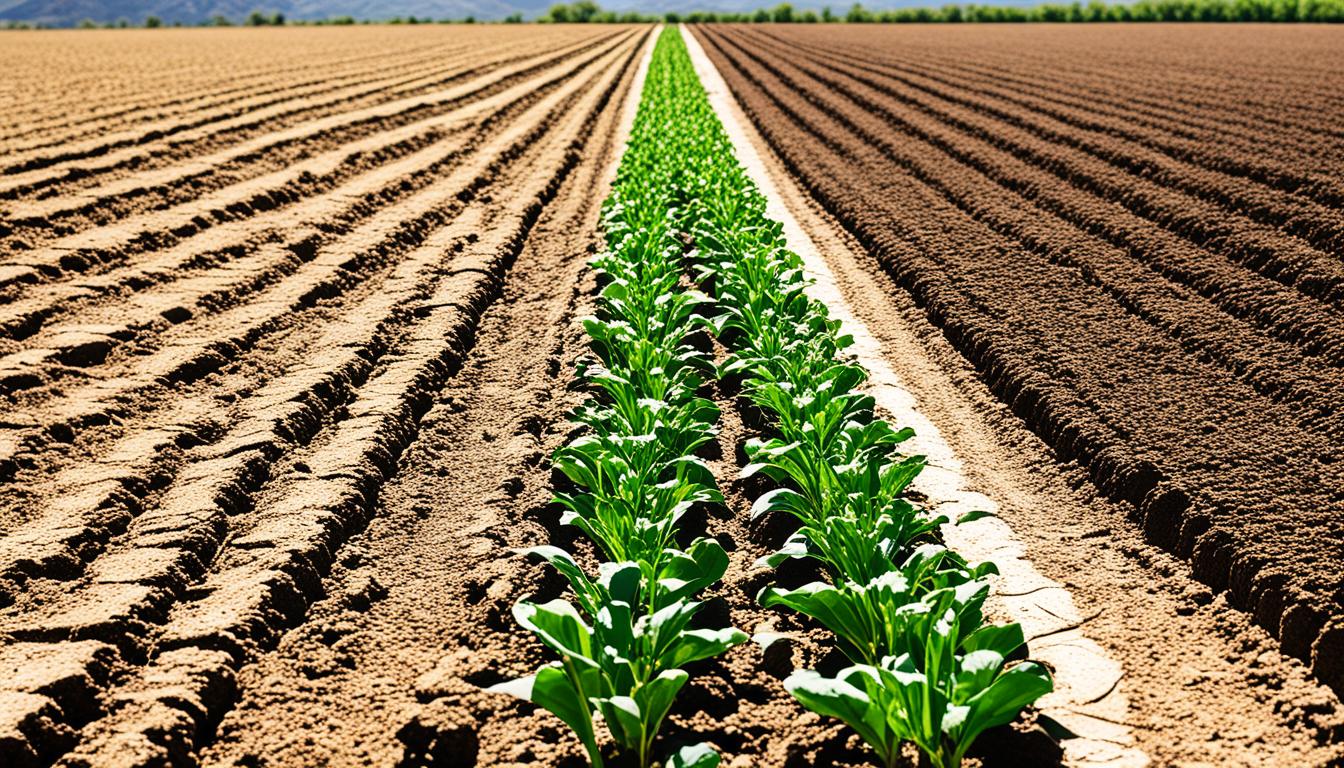
In 2018, Bhatta and team discovered new genetic areas for grain yield in drought-stressed wheat. This highlights how scientific progress helps make crops resistant to drought. It’s key for ensuring we have enough food, especially in a changing climate.
The world is experiencing unusual weather patterns and longer droughts. This makes it crucial to farm in sustainable ways. Scientists are now using a mix of old and new methods to grow crops that survive in dry lands.
These new techniques are not just about keeping farm yields up in risky areas. They help make farming more sustainable all around. The goal is to keep food coming even when the weather gets tough. Drought-resistant crops are a big part of our fight against climate change’s effects.
The need for drought-resistant crops is now key in today’s farming. This is especially true with less water globally, putting crops at risk. The problem is made worse by the changing climate, leading to odd and extreme weather.
Drought-resistant crops are vital for saving water on farms. A 2016 study by Daryanto, Wang, and Jacinthe showed drought really hurts maize and wheat around the world. They said it’s critical to make crops that handle tough environments. This keeps food supplies steady when water is short.
Climate change causes more droughts and hurts crop growing. This makes drought-resistant crops very important. In 2016, Mwadzingeni and team talked about making wheat that grows better in dry times. They stressed the need to keep getting better at this work. In a similar study in 2017, Gupta and others looked into what makes wheat withstand drought. They agreed that it’s essential to include stress coping in how we grow crops.
Improving how we grow crops can really help food systems. Bhatta and colleagues in 2018 discovered ways to get more grain from drought-hit wheat. This shows the power of using newer methods in farming. Plus, Borisjuk’s 2019 and Przewieslik-Allen’s 2019 work showed how to use genetics to make wheat stronger. This includes genetic changes and using special markers to pick the best traits.
Fighting water scarcity with drought-resistant crops is really smart. This approach helps us use water better and deal with changing environments. By making crops that can survive tough times, we protect our food supply. This is key for feeding the world, even when the weather goes haywire.
For many years, traditional plant breeding has been vital in making crops more resilient. This is especially true for drought-tolerant genetics. By using the diversity found in plants, we can make them more adaptable and strong.
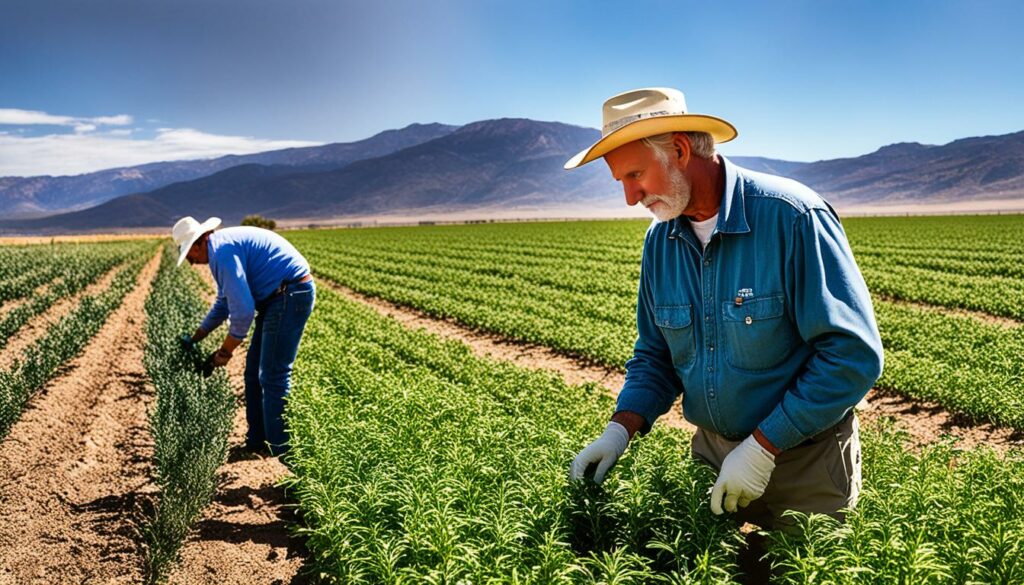
Knowing the genetic differences in crops is key to traditional breeding’s success. This method allows us to pick and mix plants that naturally cope well with drought. A study in 2012 showed that crops around the world deal with drought differently. This shows us where we can focus our efforts.
There are many examples of how traditional breeding has helped create drought-tolerant crops. In India, the Central Soil Salinity Research Institute managed to make rice, wheat, and Indian mustard types that can survive salty soil and drought. In 2013, a report from South Africa talked about the success of using local plants and traditional crops in fighting against drought.
| Year | Study Focus | Key Findings |
|---|---|---|
| 2012 | Global Crop Sensitivity to Drought | Highlighted the varying drought sensitivities of grain crops worldwide. |
| 2013 | Effect of Drought on Plant Yield | Detailed the impacts of drought and heat on plant growth and yield. |
| 2015 | Underutilised Crops in Sub-Saharan Africa | Discussed potential future crops for water-scarce conditions. |
| 2016 | Conservation Priorities for Crop Wild Relatives | Identified global conservation priorities to preserve genetic diversity. |
| 2019 | Importance of Crop Diversification | Emphasised diversifying crops for food and nutrition security amidst climate change. |
Using traditional plant breeding is key to making crops able to survive drought. By doing this, we help our agriculture to be more sustainable. It also keeps the genetic diversity of our crops alive.
Genetic engineering has revolutionised the creation of drought-resistant crops. Scientists find and add important genetic traits to plants. This helps plants survive tough environments better. We will explore these techniques and the achievements they bring.
A key method in making crops stronger is transgenesis. This moves genes from different sources into plant genes. Another technique, called genome editing, uses tools like CRISPR/Cas. It can change plant DNA precisely. These methods are used a lot to make plants tough against drought. They have been very successful in this.
These techniques have led to great successes. New crops not only survive but do well in little water. For example, Yield Protection Technology (YPT™) from Performance Plants Inc. has improved canola’s output in dry conditions. It doesn’t harm the plant’s usual performance, though.
In 2020, a Front Plant Science study showed we can make wheat and maize withstand drought more. Tests in different places proved these plants are better, celebrating the achievements of GM crops. This progress is important for ensuring we can feed the world despite climate change.
Transgenic wheat, made with a sunflower gene, outperformed non-modified wheat, as shown by González et al. (2019). This proves the success of genetically modified crops.
CRISPR/Cas9 is changing how we create crops that can survive droughts. It does so by precisely changing genes that control how plants handle stress. This technology is greatly changing agriculture and helping us fight the effects of climate change on our crops.
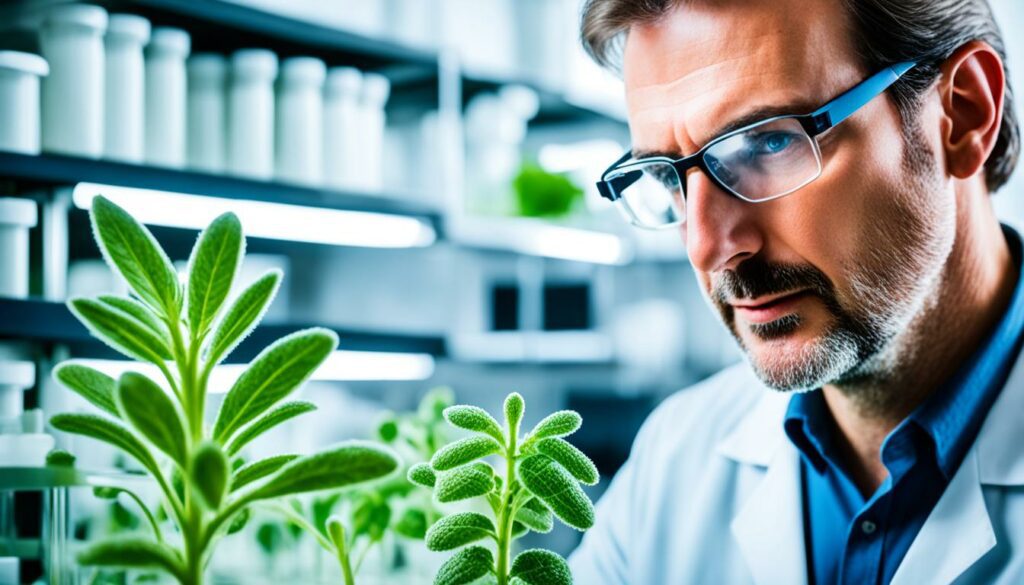
This method allows us to edit genes directly, offering key improvements in drought resistance. Traditional methods couldn’t be as quick or specific in solving drought issues. With CRISPR/Cas9, we can enhance a plant’s abilities to cope with dry conditions.
For example, research has improved maize’s resistance to drought by tweaking the ARGOS8 gene. It led to better grain yields when water is scarce.
Studies have shown that using CRISPR/Cas9 can make crops like maize and soybeans better at handling drought. In Texas, scientists have grown maize and soybean varieties that are less affected by lack of water. By using CRISPR to tailor plants’ responses to drought, they saw big improvements.
This technology also helps seeds grow better even when conditions are tough. It proves how powerful CRISPR technology can be in making our crops stronger and more resistant.
“The CRISPR/Cas technology is a precise genome editing method with potential applications in gene therapy and crop improvement, as highlighted in studies published on NCBI.”
Table showing the comparative yield performance under drought conditions:
| Crop | Traditional Variety Yield (kg/ha) | CRISPR-Edited Variety Yield (kg/ha) | Percentage Yield Improvement |
|---|---|---|---|
| Maize | 5000 | 6500 | 30% |
| Soybean | 3000 | 3900 | 30% |
| Rice | 6000 | 7500 | 25% |
Applying CRISPR/Cas9 makes crops like rice and maize better at surviving drought. This shows how genetic engineering is key in making agriculture more resilient to climate change. It opens the door to growing crops that can weather dry spells better.
Learning about plant physiological adaptations helps make plants more resilient to drought. These drought survival strategies reduce water loss and boost water absorption, key in dry areas. For example, under drought stress, plants lose 35% of their productivity (Anjum et al., 2011).
Plants adapt by closing their stomata to lower water loss, growing longer roots to find deep water, and making compounds like proline. Such changes keep their cells healthy during drought. Adding biochar to soil improves these processes, leading to an 11% boost in crop growth in dry regions (Diatta et al., 2020).
Using phosphate-solubilizing bacteria with extra phosphorus also helps. This method leads to a 26% growth improvement in maize under salty and dry conditions (Adnan et al., 2020). It shows how natural and human-assisted changes can work together to save water in plants.
With these methods, new crops like the Swarna rice stand out. Swarna rice can survive drought 15% better than others (Ortiz et al., 2015). This approach highlights how combining biology and genetics can boost crops’ resilience. It helps them thrive in harsher climate environments.
“Models predict a substantial 40% increase in watering needs due to climate change impacts on global water availability.” – Konapala et al., 2020
Thus, a full-spectrum strategy doesn’t just deal with water issues now. It builds our ability for sustainable farming, safeguarding crop production in the future.
Plants respond to many types of abiotic stress, like drought and extreme temperatures. They change physically and biochemically to survive tough conditions. These adaptations help them deal with stress and maintain their growth.
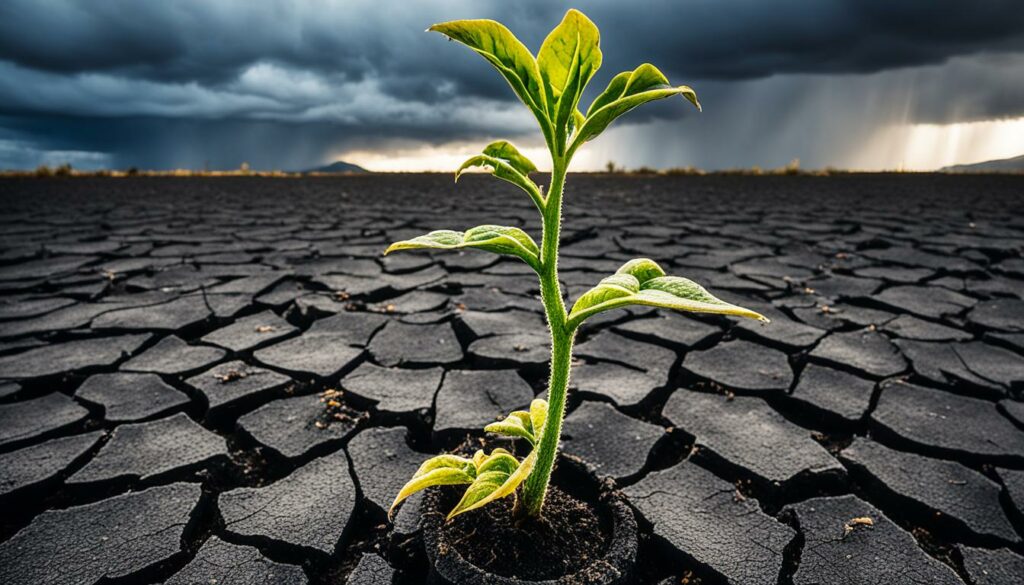
When plants face drought, they change a lot. They reduce growth and suffer from various issues like leaf burning. But, they have clever ways to survive. One of these ways is adjusting how much water they lose through their leaves.
Inside the cells, plants do a lot to keep functioning during drought. They make special substances to stay hydrated and protect their cell parts. They also fight off harm from reactive oxygen species with special enzymes and antioxidant systems.
Scientists are studying genes that help plants deal with stress. This research is key to improving crops using methods like CRISPR-Cas9. It helps us understand how plants can grow better in difficult environments.
For example, the StDDP7 gene in potatoes is very active under salt stress. It shows how complex and interesting plant stress responses are.
| Abiotic Stressor | Impact on Plants | Adaptation Mechanism |
|---|---|---|
| Drought | Reduced growth, leaf senescence | ABA-mediated stomatal regulation, osmotic adjustment |
| Salinity | Ion toxicity, poor water uptake | Ion homeostasis, compatible solute accumulation |
| Extreme Temperature | Protein denaturation, membrane fluidity changes | Heat shock proteins, antioxidant response |
| Heavy Metals | Oxidative damage, disrupted metabolism | Metal chelation, sequestration |
Abscisic acid (ABA) is key in helping plants deal with drought. It controls the closing of stomata, which stops the plant from losing water through evaporation. This keeps the plant’s water level balanced when it’s dry.
In drought, plants make more ABA. This high ABA level starts a chain reaction that helps the plant survive with less water. A good example is how it tells the guard cells to close the stomata, cutting down on water loss.
“A study by Ali S. et al. (2020) highlighted the crucial role of ABA in drought stress tolerance.”
ABA’s job doesn’t stop at closing stomata. It also starts processes that help the plant cope with dry spells. For example, it causes the plant to make substances like proline and glycine betaine. These protect the cells from the stress caused by drought. Trivedi D.K. et al. (2016) found that ABA is really important for a plant’s ability to handle tough times.
| Study | Findings |
|---|---|
| Ali S. et al. (2020) | Highlighted ABA implications in drought stress tolerance |
| Chaves M.M. et al. (2003) | Detailed plant responses to drought from genes to the whole plant |
| Trivedi D.K. et al. (2016) | Explored ABA biosynthesis, regulation, and role in abiotic stress tolerance |
| Kim T.-H. et al. (2010) | Delved into the guard cell signal transduction network involving ABA |
New findings are teaching us more about how ABA and other hormones work together. These hormone interactions help plants survive drought. In the end, ABA’s many roles in helping plants cope with little water are very important.
Looking into the future, genetically modified crops show a lot of promise. But, they face challenges, like winning over the public and dealing with policies. To make people trust these crops more, being open about their benefits and dealing with worries is key. This can help grow their acceptance in the market.

Many people worry about GM crops’ safety, their impact on the environment, and if they are ethical. Despite the positive potential they bring, like being more resilient to drought, added nutrition, and stronger farms, many stay doubtful. A study in Genome shows we need to educate the public. It points out how essential genetic modifications are for meeting future wheat production goals.
The rules and checks for GMOs differ around the world, shaping their future differently. Some places have strict approval steps which delay getting these new crops to market. Switching from older methods to newer ones, like genome editing, also faces complex checks. It’s important to move fast but keep things safe and according to global rules. Such work gets strong support from studies, showing it’s vital for the future of drought-resistant crops.
Soon, new genetic technologies might revolutionize farming. They could improve both the amount and quality of crops through more precise and diverse approaches. By dealing with what people think and making the approval rules better, we can make these new farming methods better understood and accepted. This would let us fully benefit from the great innovations in agriculture.
It’s vital to use water wisely in farming to boost crop yield and be eco-friendly, particularly in areas with little rain. Two main methods that work very well are drip irrigation and mulching.
Drip irrigation is great because it lowers water waste by putting the water right where plants need it. By doing this, it cuts down on the water lost to the air and the ground. This makes it a key part of sustainable farming methods.
Using microirrigation methods, as supported by NRCS Practice 441, boosts how well farmers use water. This saves valuable water resources.
Smart irrigation systems with VRA tech are even better. They adjust water use based on how moist the soil is right now. Since farming uses 70% of the world’s fresh water, it’s important to adopt these high-tech methods for farming to last.
Mulching is key for saving soil moisture. It covers the ground, which keeps the soil from heating up and losing water to the air. For example, at a farm in New York, the soil could be nearly 50 degrees cooler with just an inch of mulch.
NRCS has methods like Practice 484 Mulching that keep soil cooler and damper. This helps crops stay healthier.
Cover crops, like those suggested by NRCS Practice 340, make the soil richer and better at holding water. Adding more organic material to soil is a big deal too, as it can help land retain a lot more water. This is key when there’s not enough rain.
Practices like NRCS Practice 528 Prescribed Grazing help pastures keep moisture and stay cooler during dry spells. By using mulching and other clever methods, farmers can keep their soil healthy. This is very important against weather changes.
Both drip irrigation systems and mulching are crucial for saving water in farming. They help manage soil moisture well and use high-tech ways to water crops. This way, we can keep farming going strong without a lot of extra water.
Adapting our agriculture to a changing climate is crucial. This includes creating crops that can withstand extreme weather. Imagine the impact on our food and poverty without this safety net.
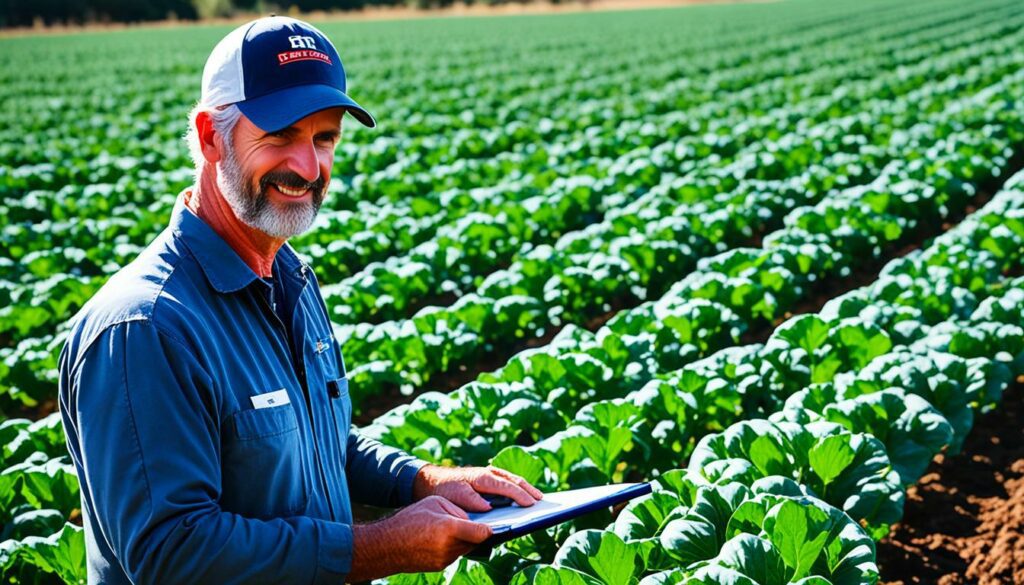
Crop diversification is key for resilience. It reduces the impact of bad weather on crops. For instance, using crops that mature early or can survive heat or drought is vital. But not everyone adopts these easily, showing the need for strategies that fit all kinds of farmers.
Here’s how climate change affects crops and the benefit of planting different types:
| Trait | Prevalence |
|---|---|
| Drought Tolerance | Most Prevalent |
| Water-Use Efficiency | Second |
Enhancing crop resilience is complex but doable. Strategies such as growing different crops in one field or changing crops yearly can help. The success depends on many factors, including how much farmers know and the help they get.
With climate change, important crops could see their yield drop by 30%. Therefore, we must invest in making crops more resilient. Yet, reaching small farmers with these new methods is still a challenge in many places.
Here’s a summary of what works to make crops stronger:
| Strategy | Description |
|---|---|
| Intercropping | Combining different crops in the same field to reduce risk |
| Crop Rotation | Alternating crops to prevent soil depletion and control pests |
| Utilising Genetic Diversity | Incorporating diverse traits to enhance stress tolerance |
Field trials help take research from the lab and apply it to real farming. Experts test if drought-tolerant traits work in different real-life situations. This is key for improving crops we grow.
In field trials, many factors must be considered like soil types and weather. Each test is carefully designed to see how well genetically changed crops do in the real world. Having control tests and regular tests lets researchers get accurate information on crop yield and resilience.
Several success stories have come from field trials. For example, wheat with a sunflower gene showed it can handle drought better and produce more than usual. This proves how genetic changes can really improve crops.
Below is a table summarising important studies on drought and how technology helps:
| Study Focus | Key Findings |
|---|---|
| Impact of Disasters on Agriculture | Droughts significantly affect crop production and cropping areas. |
| Drought and Food Security (NOAA) | Drought severely impacts crop yields and agricultural productivity. |
| Historical Changes in US Maize and Soybean Production | Observed spatiotemporal patterns and changes due to drought. |
| CRISPR/Cas Technology | Enhanced drought-resistant crops, including award-winning applications. |
These studies show how important and effective advanced field testing is. Success in these trials leads to better drought-resistant crops in the future.
When we explore ways to make plants better at fighting drought, we face big challenges. One key problem is how plants react to stress. This involves many genes working together. It’s hard to figure out just how to change them to get the results we want.
| Challenge | Example | Study/Source |
|---|---|---|
| Complexity of Stress Response Pathways | Hundreds of genes involved in drought stress response | Gene expression experiments |
| Environmental Influence on Trait Expression | Drought effects on maize and wheat production | Daryanto et al., 2016 |
| Genetic Trade-offs | Enhanced stress tolerance vs. overall yield | Observed in transgenic crops |
| Potential Impacts on Crop Yield and Quality | Reduced grain yield under stress | Bhatta et al., 2018 |
Issues in farming like not having enough water also slow down progress. Water scarcity can lead to big losses in crop yield. This problem is especially serious in places likely to run low on water, like Africa. By 2025, about 480 million people there could feel the impact.
Some success has been seen with YPT™, a technology tackling drought by Performance Plants Inc. But, the challenge with how the environment affects these changes and the trade-offs we face are still there.
It’s important to remember how any genetic changes might affect the total crop you get and its quality. For example, Bhatta et al. found regions in wheat’s DNA that influence grain yield under drought. This shows there could be a cost to better stress tolerance.
There have been advances in understanding plant genetics, like by Gupta et al. and Mwadzingeni et al. But, making crops better still has its limits. We need to carefully handle these limits for lasting success.

We’re on a mission for sustainable farming that is both productive and kind to the planet. Since the 1950s, farming has been a big source of harmful gases. We must now use farming methods that protect the earth.
The Agricultural Resilience Act (ARA) aims to fight climate change using USDA programmes. It helps both farmers and the whole food process be more eco-friendly. Many people back these efforts, showing how important they are.
The Inflation Reduction Act (IRA) of 2022 increases money for green farming. It funds projects that cut harmful emissions. The ARA goes even further by funding research, helping the meat industry go green, and fighting food waste.
The Rally for Resilience showed that farmers need to lead in fighting climate change. It also highlighted the importance of fairness in farming policies.
The ARA now focuses on farming methods that are better for the planet. It wants farmers to grow crops that last, use more grass-fed animals, and manage nutrients carefully. This approach helps farming be good for nature, make money, and be fair.
Funding through the ARA helps set up centres for agricultural resilience and supports new researchers. It focuses on the latest ways to farm well. This includes encouraging research in eco-friendly farming.
Sustainable farming looks at the big picture. It cares for the soil, uses less water, and reduces pollution. This mix of science, economics, and community building helps avoid the downsides of current farming, like soil damage and pollution.
Caring for water is key in sustainable farming. It means using water wisely, growing plants that don’t need much water, and keeping water clean. This way, farming can go on for many years without harming the environment.
In the end, making our food system strong and eco-friendly is essential. We need both smart research and new farming methods. With these efforts, we can fight climate issues and make farming last for the future.
The future of crop science is changing fast. Major companies such as BASF and Bayer are leading the way. Through big investments and teamwork, they’re changing how we grow crops.
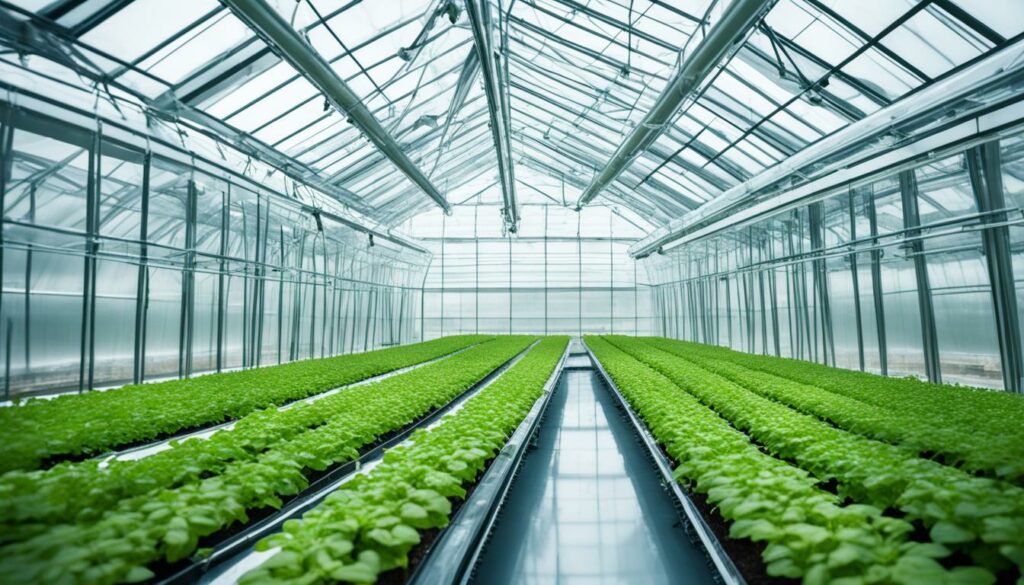
New tech is a game-changer in farming. Genomics and phenomics are paving the way for better crops. One cool technology, minichromosomes, helps plants deal with tough environments better.
Working together globally is key in farming. Projects like Crops of the Future show how we unite for good. By combining our knowledge and money, we’re making crops stronger against bugs, diseases, and bad weather.
Investing in getting new crops to markets is a big challenge. But, working together, companies can save money and speed up new crop development. This way, we get stronger and healthier plants.
Many US farmers now use advanced plant types. For example, over 90% of corn and cotton are genetically changed. These changes help protect the plants and make farming more efficient.
The journey to create drought-resistant crop types is a big achievement. It’s part of a plan to keep farming healthy and make sure the world always has enough to eat. Because of things like not enough rain, about 70% of what we could grow is lost each year.
By 2025, over 480 million people may face very dry conditions in Africa. This shows how urgent making crops that can survive tough times is.
Many efforts have been made to grow plants that don’t need as much water. For crops like rice, wheat, Indian mustard, and maize, special kinds have been bred that can handle dry spells.These traditional methods have joined forces with modern science. Through genetic engineering, scientists have created crops that can grow better in dry conditions. This technology, like adding the DREB1 and DREB2 genes, has improved some crops’ harvests by 15-25%.
One exciting solution in this field is the Yield Protection Technology™ (YPT™) by Performance Plants Inc. It focuses on creating crops that can survive droughts. This is crucial because almost all water use in dry places is for farming.
By combining old methods, like selective breeding, with new ones, like genetic engineering, we can build a future where our food production doesn’t depend so much on the weather. This mix will help us keep eating well, no matter the climate, for a long time.
Developing crops that can survive drought is key for making sure we always have enough to eat. This is especially important with climate change happening. These crops let farmers keep growing even in places with little rain. They also help the earth stay healthy.
Climate change brings wild weather, like more common and worse droughts. This hurts how much food we can grow. The hard conditions make it tough for plants to live. That’s why it’s so vital to develop crops that can deal with hard times.
Farmers have long picked and mixed plants that can handle drought well. They look for strong, natural features in different plants and make new, tougher kinds. For example, they’ve made rice and wheat that don’t need as much water to grow.
Scientists can now pick specific genes to make crops fight drought better. They use high-tech tools to change a plant’s DNA, making it tougher. This has helped make crops like wheat and maize better at surviving dry spells.
CRISPR/Cas9 is a tool for cutting and changing DNA very precisely. It’s used to improve drought resistance in crops by editing their genes. For example, in maize, it has helped make better crops without harming their growth.
Plants have smart ways to deal with less water. They close their pores to save water, grow more roots to find water, and make special substances to protect themselves. These tricks help them survive when water is scarce.
Plants change a lot to handle drought. They use less water, work harder to take in what they can, and make substances to keep their cells from drying out. Special proteins step in to help protect the plants from drying up.
Abscisic acid helps plants react to not having enough water. It tells them to save water by closing up. When there’s less water around, this acid makes sure plants use what they have wisely.
GM foods face tough questions around public opinion, rules, and whether they’re okay to use around the world. These things can slow down how quickly new GM plants are used. But they’re important for making sure we can grow enough food in hard times.
There are smart ways to use less water in farming, like dripping water right at a plant’s roots and covering the soil to stop water from escaping. These not only save water but also protect crops when it’s dry, making farming more sustainable.
Growing different crops helps protect against many kinds of weather problems. Mixing what we grow and how we grow it makes sure we’re ready for drought, heat, and salty soil. This diversity makes our food system stronger.
Scientists carefully test new crops in the real world to see if they can handle tough conditions. These tests are vital for moving new ideas from the lab to the farm. For instance, a test with special wheat has shown these new crops can be great in dry places.
Making plants ready for drought is hard because it depends on many factors. Sometimes, improving one thing in a plant means losing something else. Plus, we don’t want to hurt how much food we get. It’s a big challenge that keeps researchers looking for new ways.
To farm in a way that lasts, we need to be smart about how we use the land and what we put in it. This includes keeping the environment healthy and not using too many man-made things. These choices help our farms stay strong and keep delivering food for years to come.
New tools like genomics and special ways of farming offer great chances to make crops that can grow in tough places. By working together around the world, scientists are finding better ways to grow food, even when the weather is hard.